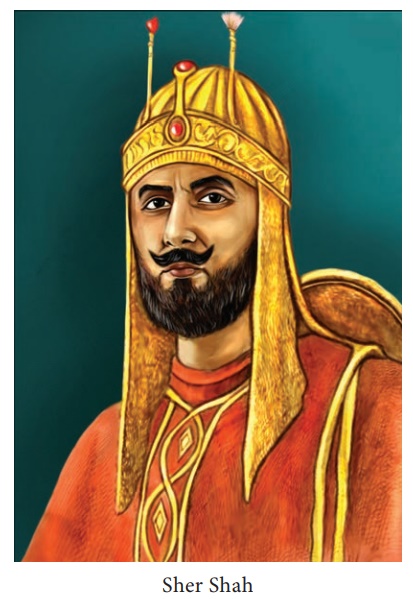The Mughal Empire - Sher Shah and Sur Dynasty | 11th History : Chapter 14 : The Mughal Empire
Chapter: 11th History : Chapter 14 : The Mughal Empire
Sher Shah and Sur Dynasty
Sher Shah and Sur Dynasty
From the time Humayun abandoned the throne in the
Battle of Kanauj to his regaining of power in 1555 Delhi was ruled by Sher Shah
of the Sur Dynasty. Born in the family of a Jagirdar and named as Farid, he
received the title of Sher Khan after killing a tiger (sher in Hindi). When he
ascended the throne, he was called Sher Shah. Through his ability and
efficiency, he emerged as the chief of Afghans in India. His military
capability and diplomacy made him victorious over Humayun and many other Rajput
rulers. Malwa fell without a fight. Rana Uday Singh of Mewar surrendered
without resistance. Sher Shah’s next venture to capture Kalinjar failed as a
gunshot caused his death in 1545. Sher Shah was succeeded by his second son
Islam Shah who ruled till 1553. His death at a young age led to a state of
confusion about succession. Humayun used this opportunity to regain Delhi and
Agra from the Sur rulers.

Sher Shah’s Reforms
When Sher Shah was pursuing Humayun, he had left
Khizr Khan as the Governor of Bengal. Khizr Khan married the daughter of the
former ruler of Bengal, Sultan Mahmud, and started behaving like a king. On his
return Sher Shah ordered him to be put in chains. As one familiar with the
problem of provincial insubordination, he thought that the real solution to the
problem would be to set up a strong administrative system. So he made his
government highly centralised. The local administrative structure of the Delhi
Sultanate was followed with certain changes. The village headmen who were made
responsible for the goods stolen within the area under their control became
vigilant. The welfare of the peasants was a prime concern. When the peasant is
ruined, Sher Shah believed, the king is ruined. Sher Shah took great care that
the movements of the army did not damage crops. He followed a flexible revenue
system. Land was surveyed and revenue settled according to the fertility of the
soil. In some areas, the jagirdari and zamindari systems were allowed to
continue. In yet other places he arranged to collect only a portion of the
gross produce.
Jagirdari
It is a land tenure system developed
during the Delhi Sultanate. Under the system the collection of the revenue of
an estate and the power of governing it were bestowed upon an official of the
state.
Zamindari
The term refers to another land
tenure system. The word zamindar means landowner in Persian. In Mughal times
the zamindars were drawn from the class of nobles. Akbar granted land to the
nobles as well as to the descendents of old ruling families and allowed them to
enjoy it hereditarily. Zamindars collected revenue from the tenants and
cultivators and remitted a fixed amount to the state.
Sher Shah showed the same concern while dealing
with traders. In order to encourage trade, he simplified trade imposts,
collecting taxes only at the point of entry and the point of sale. The
standardization of the metal content of gold, silver and copper coins also
facilitated trade. His currency system continued through the entire Mughal
period and became the basis of the coinage under the British.
For enhancement of trade and commerce Sher Shah
maintained a robust highway system by repairing old roads and laying down new
roads. Apart from repairing the Grand Trunk road from the Indus in the west to
Sonargaon in Bengal, he also built a road connecting Gujarat’s seaports with
Agra and Jodhpur. A road was laid connecting Lahore with Multan. The highways
were endowed with a large network of sarais,
rest houses, where the traders were provided with food and accommodation,
ensuring brisk commerce. Some of the sarais constructed by Sher Shah still
survive. These sarais also ensured the growth of towns in their vicinity.
Sher Shah practiced charity on a large scale. He
gave stipends from the treasury to destitute people. Sher Shah was an orthodox
and devout Sunni. He is said to have dispensed justice without bias, punishing
the oppressors even if they were nobles or his relatives. Through stern
punishments to rebellious zamindars and nobles and to thieves and robbers he
ensured effective maintenance of law and order in the empire.
The fiscal administration for which Akbar and Todar
Mal have been so highly praised was largely based on the methods of Sher Shah.
During his short rule, Sher Shah did not have much time for building new cities
and palaces. He started building a new walled city in Delhi, which later came
to be known as Purana Qila (Old Fort). He built his own mausoleum in Sasaram.
Related Topics